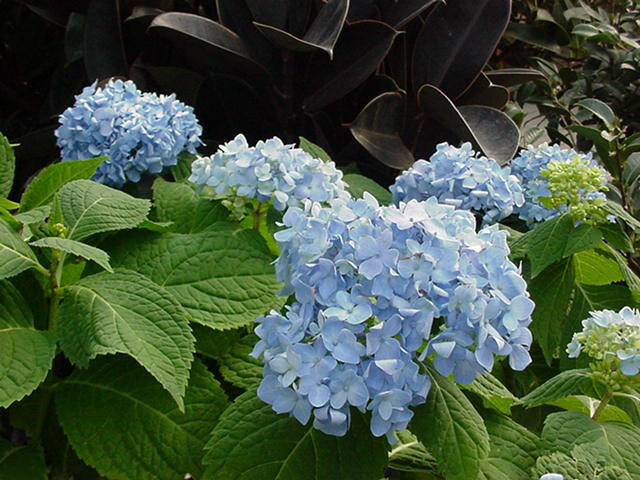
UT Gardens’ May 2019 Plant of the Month: Bigleaf Hydrangea
Submitted by Emily Hoffman, UTIA Marketing and Communications
The genus Hydrangea is expansive and includes approximately 1,000 species, hybrids and cultivars, which can be deciduous or evergreen shrubs, small trees or climbers. Hydrangea is the second most popular deciduous shrub in the United States and is produced in more than 1,500 nurseries nationwide. Hydrangeas commonly produced commercially are deciduous shrubs, selected for their showy inflorescence (flower), with some native to the U.S., while others are native to Asia.
Bigleaf hydrangea (Hydrangea macrophylla) are native to Japan and Korea and known typically for blue or pink mounds of flowers, known as hortensias, or mopheads. However, the other recognized horticultural group of H. macrophylla, known as lacecaps, though less showy, are equally beautiful and form a ring of large, sterile flowers and an inner core of small, fertile flowers. Certain selections of both lacecaps and mopheads change flower color depending on aluminum availability, which is affected by soil pH. Tennessee’s more acidic soils make it somewhat challenging to produce pink blooms, which are associated with a basic soil pH. You can add lime to lower the pH (for pinker blooms) or aluminum sulfate to further acidify the soil (for blue blooms.) After planting, wait a year to see what color the blooms come out, and then add desired soil amendments little by little. Keep in mind that some cultivars will bloom white regardless of aluminum levels.
Plants typically bloom in Tennessee beginning in late May through June and are considered hardy in USDA plant hardiness zones 6 to 9. However, hardiness varies among cultivars and selection must be made carefully to match the location. Cold injury to the flower buds and improper pruning are the usual reasons for flower failure.
Bigleaf hydrangeas form flower buds during late summer and fall and can be damaged when exposed to low winter temperatures. They will, however, tolerate root freeze. Additionally, H. macrophylla don’t prefer our summer heat and humidity, so be sure to plant them somewhere that gets dappled shade or morning sun. Early morning shade can cause foliage to stay wet longer, increasing the risk of leafspot, so morning sun can be important for that reason as well. If you see the leaves curling up in the afternoon sun, it could be a heat defense mechanism, so don’t get out the hose to water until you check to see if the soil is dry. H. macrophylla often suffers from overwatering and root rot, which can manifest as yellow foliage, chlorosis and weak root systems, particularly in the southeastern U.S. summers.
Depending on the cultivar, hydrangea range from 3 to 6 feet high and wide but can get larger. They look beautiful planted en masse. You can look for remontant or “repeat bloom” varieties that bloom on both old and new growth, such as the mophead cultivars ‘David Ramsey’, or the Endless Summer series of remontant hydrangeas which include The Original, Blushing Bride, Twist-N-Shout, BloomStruck and Summer Crush. Endless Summer BloomStuck is among the best performers in Tennessee, and Endless Summer Summer Crush is the newest in the series. ‘Twist-and-Shout’ is the only remontant lacecap type. Check the web site: www.endlesssummerblooms.com/the-collection.
Some bigleaf hydrangea cultivars are “less remontant” than others and will rebloom best if pruned after the first flush of flowers or after adding some fertilizer. Some of the top-performing mopheads (not including remontant selections) out of 250 selections evaluated by Plant Introductions, Inc. in Watkinsville, Ga., are ‘All Summer Beauty,’ ‘Ami Pasquier,’ ‘Frillibet,’ ‘Générale Vicomtesse de Vibraye,’ ‘Mme. Emile Mouillère,’ ‘Mousseline’ and ‘Nikko Blue.’ Top-performing lacecap selections are ‘Blue Wave,’ ‘Lanarth White,’ ‘Lilacina,’ ‘Veitchii’ and ‘White Wave.’
The UT Gardens includes plant collections located in Knoxville, Jackson and Crossville. Designated as the official botanical garden for the State of Tennessee, the collections are part of the University of Tennessee Institute of Agriculture. The Gardens’ mission is to foster appreciation, education and stewardship of plants through garden displays, educational programs and research trials. The Gardens are open during all seasons and free to the public. For more information, see the Gardens website: ag.tennessee.edu/utg.